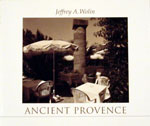Artist's Statement
In my visits to southern France over the years I have been drawn to Roman ruins. I was already interested in Roman history and culture as a result of my four-year study of Latin in high school, where we read Julius Caesar's Gallic Wars, a chronicle of the Roman conquest of ancient France. The Romans loved Provence and built roads, aqueducts, arenas, baths, and towns throughout the area. They planted olive trees, established vineyards, and quarried limestone. Visual traces of all of this activity remain throughout the region, which was referred to by the Romans simply as Provincia, the first and most important province.
I began actively photographing Roman vestiges in southern France four years ago. I am interested in depicting anachronism—the ways in which contemporary cultures collide with their pasts. This collision is articulated in both urban and pastoral settings. Language is another important site of cultural frisson and assimilation in my images—both in the advertising slogans and business signage that are situated near architectural fragments of the past, as well as in the titles I’ve given them, which are a combination of English and French.
Roman civilization forms much of the foundation for western civilization by way of engineering, language, law, and customs, and my photographs refer to these connections. Many Roman roads and bridges are still in use, sometimes in modified form. The old arenas hold bullfights derived from the Roman blood sports, and many modern buildings literally sit on Roman foundations. Numerous Gallo-Roman towns evolved into modern French ones, such as Aix-en-Provence (called Aquae Sextiae by the Romans), where Roman baths are now the site of therapeutic spas. On our first trip to the region, we stayed in a hotel in Fréjus (Forum Julii) that had a Roman column in the courtyard where we ate breakfast each morning. La Maison Carrée in Nîmes (Nemausus) and the Temple of Augustus and Livia in Vienne (Vienna) are two of the finest Roman temples in the world; the theatre in Orange (Arausio), still in use, is the best-preserved Roman theatre.
I have been inspired by the work of the great French documentary-style photographers Edouard Baldus and Eugene Atget. Baldus photographed several Roman sites in the mid-nineteenth century for the Commission des Monuments Historiques. Although my style refers to these early masters, my photographs are utterly contemporary. I often include cars, telephone poles, nuclear power plants, movie posters, and other such references to date the photographs. To add a classical feel to the pictures, I have evolved a photographic printing technique using multiple toners including gold. It occurred to me that the images would look best using a photographic printing style reminiscent of early travel photography.
It is difficult to draw a precise end to the Gallo-Roman era. Many Roman buildings were used and sometimes modified in the Middle Ages. Others served as foundations for Romanesque churches that followed, such as the cathedral at Vaison-la-Romaine (Vasio Vocontiorum). The magnificent medieval cathedral in Aix has an exposed section of Roman road running through it, and its baptistry uses the marble columns from the Roman temple originally located on this site. Roman sarcophagi, capitals, and other artifacts can also be found in Romanesque structures. My project has evolved to include some of these and other traces of the Middle Ages, but the heart of the series remains the enduring Roman presence in southern France.
The beauty of Provence has inspired writers and artists for generations. Along with its varied geography and temperate climate, the region is unique for its widespread and rich layering of history. A traveler to this most touristic land can find treasures at or beneath its surface. This project is an attempt to come to terms with my own love of ancient Provence by making photographs of its most compelling sites.
Exhibition catalogue available, please inquire:

|
Jeff Wolin
|